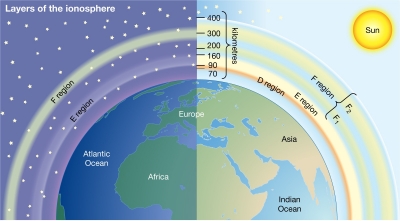
|
It is another layer, overlapping the mesosphere, thermosphere and exosphere, where radio waves are reflected. |
A dense layer of molecules and electrically charged particles, called the ionosphere, hangs in the Earth’s upper atmosphere starting at about 35 miles (60 kilometers) above the planet’s surface and stretching out beyond 620 miles (1,000 km). Solar radiation coming from above buffets particles suspended in the atmospheric layer. Radio signals from below bounce off the ionosphere back to instruments on the ground. Where the ionosphere overlaps with magnetic fields, the sky erupts in brilliant light displays that are incredible to behold.
Several distinct layers make up Earth’s atmosphere, including the mesosphere, which starts 31 miles (50 km) up, and the thermosphere, which starts at 53 miles (85 km) up. The ionosphere consists of three sections within the mesosphere and thermosphere, labeled the D, E and F layers, according to the UCAR Center for Science Education.
Extreme ultraviolet radiation and X-rays from the sun bombard these upper regions of the atmosphere, striking the atoms and molecules held within those layers. The powerful radiation dislodges negatively charged electrons from the particles, altering those particles’ electrical charge. The resulting cloud of free electrons and charged particles, called ions, led to the name “ionosphere.” The ionized gas, or plasma, mixes with the denser, neutral atmosphere.
Credit: Live Science
Picture credit: Google




